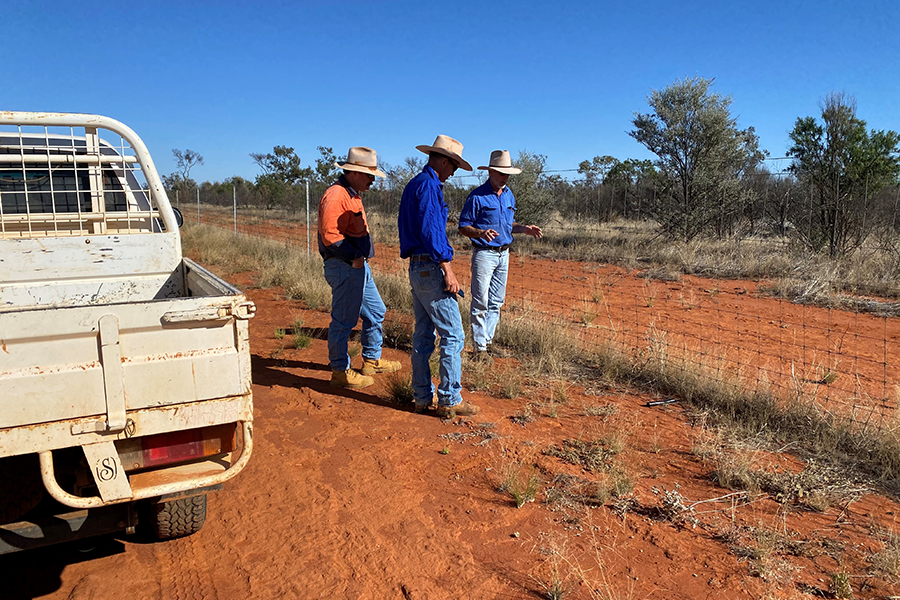
Dick O’Connell, right, Wombula Station, explains the construction of his privately funded exclusion fence to Council’s Rural Lands Officer James Theuerkauf and Thargomindah Station owner, Adam Klein
A unique program aimed at bridging the divide between Council and landholders around wild dog management is winning kudos in local government circles for Bulloo Shire.
The south-west Queensland LGA is the third largest in the State and has taken a proactive nil-tenure approach to wild dog management with a dedicated team of three staff travelling thousands of kilometres to meet remote landholders face-to-face to help resolve issues.
A finalist in the Local Government Excellence Awards, Bulloo’s Rural Services staff notched up 8,000km last financial year talking to landholders about baiting coordination and training, chemical certificates/training, exclusion fencing, drought support, water agreement facilitation, invasive animal and plant management and providing wellbeing support.
Although wild dogs are front and centre for many of the landholders, the team has also facilitated training programs in property mapping, bovine pregnancy testing, creek repairs, farm safety, and livestock supplementation.
Team members draw on resources from PestSmart, Feralscan, AgForce, Southern Queensland Landscapes and Department of Agriculture and Fisheries.
Rural Services Manager Donna Hobbs developed the program from the ground up following a suggestion from Bulloo Mayor John Ferguson the disconnect between Council and landholders needed to be resolved.
“Council wanted to provide valuable services to the landholders,” Ms Hobbs said.
“Our Rural Lands Officer now has a liaison focus so he is not just spraying weeds or helping someone set a dog trap but is talking to landholders about their issues.
“We fill gaps, support and connect people.”
The staff, often accompanied by a mental health nurse, visit 27 landholders spread across the 73,000sqkm shire, with the furthest station located a 3.5-hour drive on unsealed roads.
“Not only are they remote but are bordered by NSW and SA who have their own regulations raising cross border issues for landholders. We are on the Border Regional Organisation of Councils to try and solve some of those,” Ms Hobbs said.
“We held wild dog trapping workshops and included mental health and wellbeing with Queensland Feral Pest Initiative funding.”
The funding has enabled a coordinated strategic aerial 1080 baiting program covering 795,557ha and wild dog trapping and monitoring assistance for three properties covering 178,200ha.
Two co-ordinated aerial 1080 baiting programs in November 2020 and May 2021 resulted in 11 wild dogs trapped, two shot, 34 scalps received and 8,962kg of bait meat distributed.
Council provides subsidised meat baits to encourage landholder participation in wild dog management.
Ms Hobbs said Rural Services works collaboratively with NSW Local Land Services, and neighbouring Quilpie and Paroo Shires on simultaneous and coordinated baiting campaigns.
She paid tribute to the groundwork undertaken by the Western Queensland DogWatch Committee funded by AgForce and Australian Wool Innovation.
“We aim to reduce ad hoc baiting and achieve a blanket approach from St George at the border to the north of the state,” Ms Hobbs said.
“Three years ago, we did have quite a large wild dog problem but since everyone has been committed to the aerial and ground baiting and trapping programs the dog numbers have steadied up in the last 12 months.
“People are putting that down to continued effort but if we take our foot off the pedal it will creep back quickly.”